| Places |
|
|---|---|
| Accession Number | AWM2021.7.6 |
| Collection number | AWM2017.301.1 |
| Collection type | Digitised Collection |
| Record type | Wallet |
| Item count | 1 |
| Object type | Diary |
| Physical description | 126 Image/s captured |
| Maker |
Clarke, John 'Jock' Edward Rea |
| Place made | Australia, British Mandate of Palestine: Palestine, Egypt, French Mandate for Syria and Lebanon: Syria, Netherlands East Indies |
| Date made | 1940-1942; 2007 |
| Conflict |
Second World War, 1939-1945 |
| Copying Provisions | Digital format and content protected by copyright. |
Wallet 2 of 2 - Transcript of war diaries of Major John Edward Rea Clarke OBE, 1940-1942, 2007




































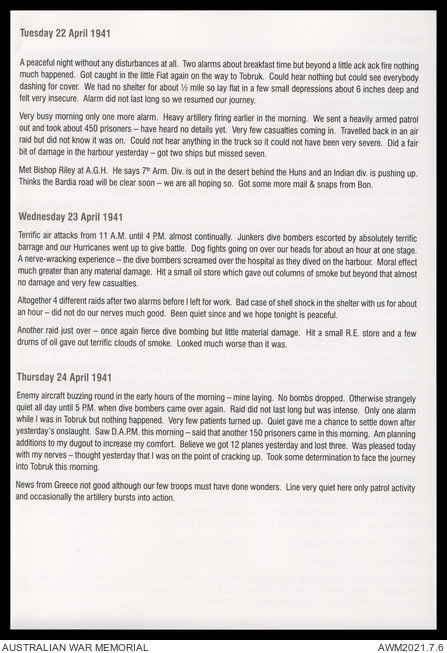












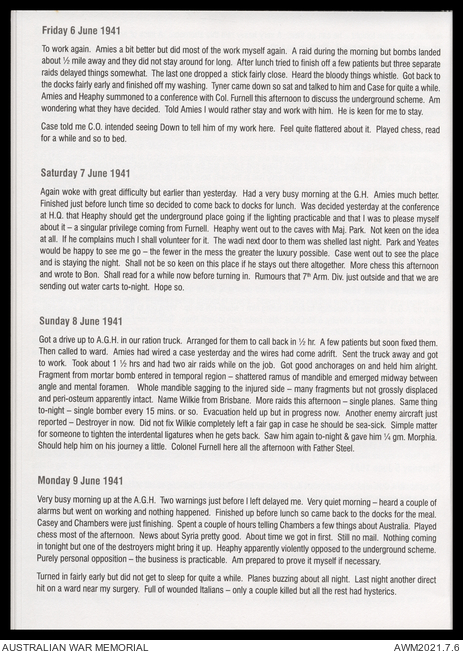





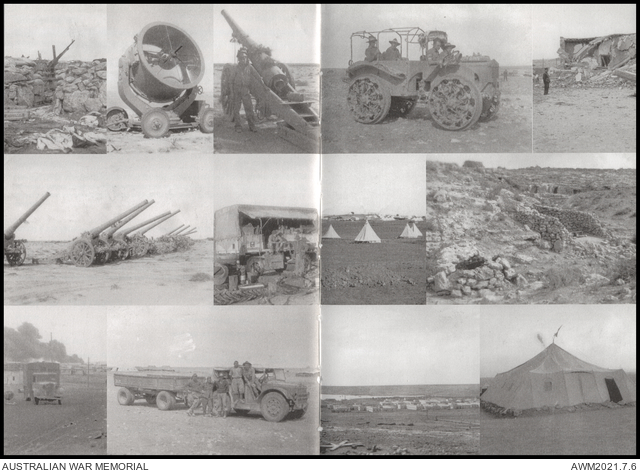





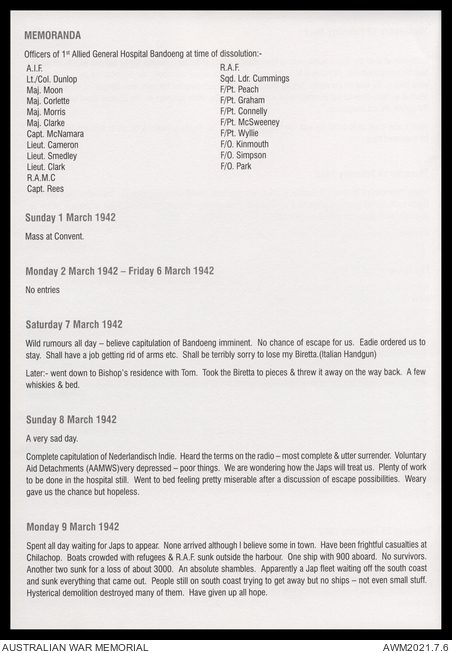




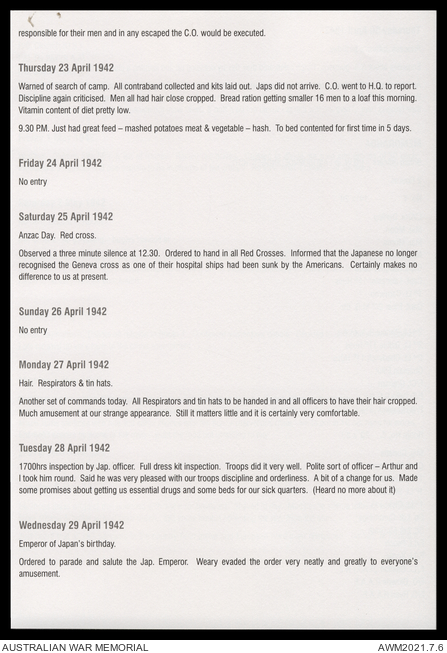




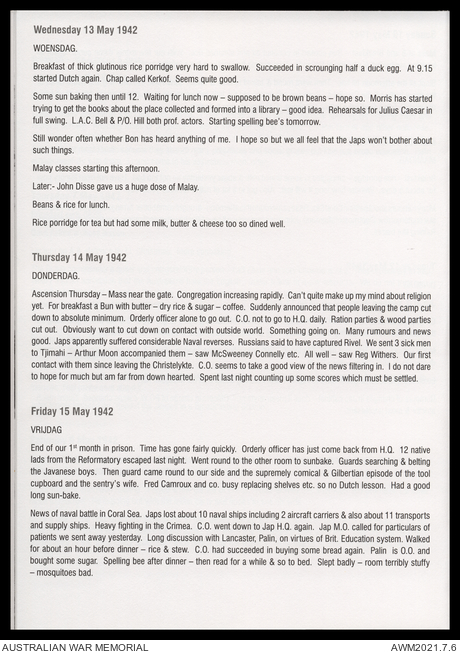





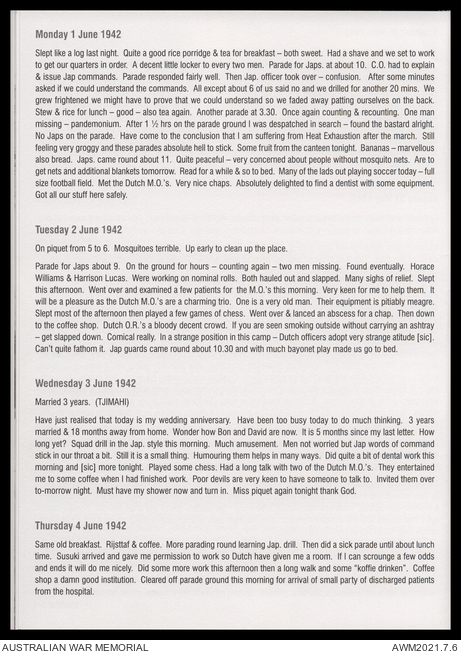











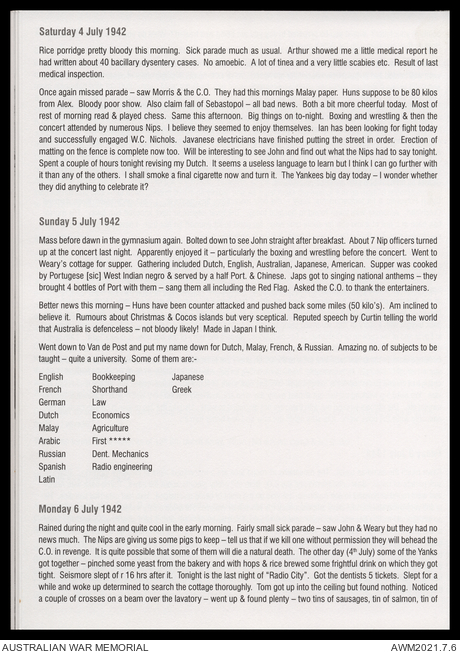
















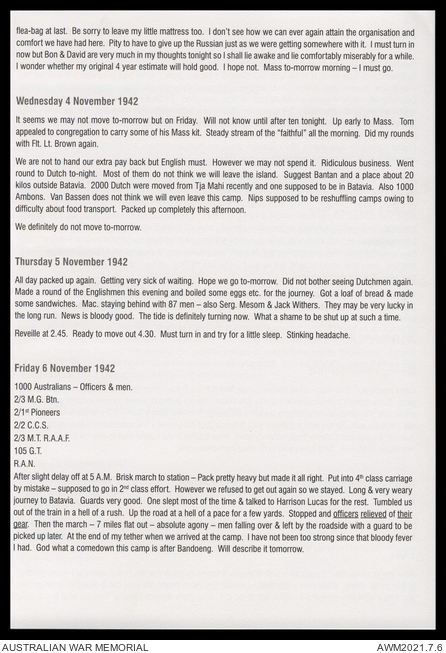
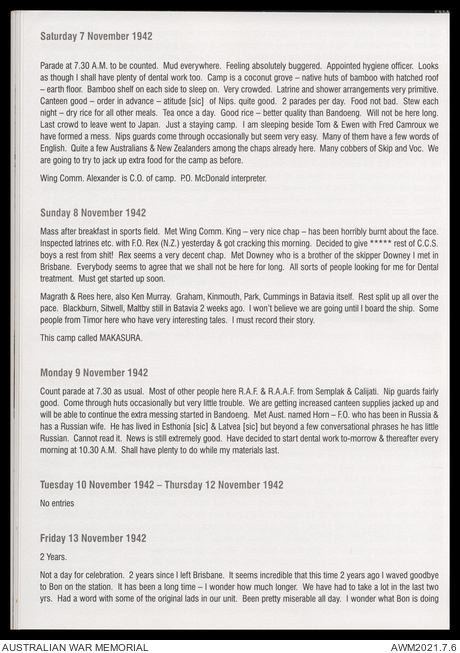


















Collection relating to the Second World War service of QX6245 Major John 'Jock' Edward Rea Clarke OBE, Australian Army Dental Corps, Libya, Egypt and Netherlands East Indies, 1940-1942.
Wallet 2 of 2 - Wallet consists of a black-covered typed transcript of two diaries, with an image of Clarke and "War Diaries of J.E.R. Clarke Capt. Q.X.6245 [sic]" in embossed gold lettering on the cover, and the same text on the spine. The transcript includes additional facsimiles of photographs, citations, and pages from the original diaries. The front matter of the bound transcript contains hand-written notes from the family of Major Clarke.
The below description of the diaries' contents is taken from the description of Wallet 1 of 1:
Diary 1 is a Palestinian-issued, green-covered, rebound diary with the original front and rear fabric cover attached to the new binding cover. The cover reads "Office-Diary 1941" and the same in Hebrew. The diary begins with several blank pages, then diary entries for the period spanning 13 to 21 November 1940 written in the 'addresses' section. These entries relate to leaving Brisbane for Sydney, then the sailing of the HMT Orion from Sydney to the south of Tasmania, before continuing to the Middle East. The diary continues with entries from 1 January 1941 and spans the period until 20 August 1941.
The diary's 1941 entries begin with Clarke in Jerusalem, then Cairo and other military-related places in Egypt such as El-Kantara, until 28 January. During this period, the diary discusses Clarke undertaking training, amassing supplies, and time spent on leave. On 28 January Clarke arrives in Tobruk, where he spends the rest of the period discussed in the diary, up to 20 August 1941. On arrival in Tobruk, Clarke discusses his difficulty establishing a dental surgery and obtaining sufficient supplies - a theme that continues throughout both diaries. Throughout his time in Tobruk, Clarke mentions the almost daily Germany aerial offence being wrought upon Allied soldiers. This includes frequent descriptions of the aircraft he witnesses from both sides, their apparent flying techniques, the sounds of bombs, the dropping of booby-traps such as pens and thermos flasks, defensive measures undertaken by Allied soldiers, and the general sentiments of soldiers. The diary also includes details of the effectiveness of Axis attacks on Tobruk, such as casualties and targets destroyed.
Diary 2 is a small, blue-covered rebound diary with the original black front and rear fabric cover attached to the new binding cover. The cover reads "Pocket Diary 1942" in printed yellow ink. This diary was hidden in the lining of Clarke's cap when not being used during his internment as a prisoner of war of the Japanese. The diary spans the period 18 February to December 1942, with preceding dates' pages completely missing from the diary. The diary begins with Clarke's arrival at Priok, and then movement to Bandoeng. It is apparent from this early entry, that Clarke and those around him are resigned to their fate of becoming prisoners of war, despite the fact that the Japanese have not captured them. The diary then goes on to describe Clarke and his unit's physical and mental preparation to becoming prisoners of war, highlight the lowering of morale, and the increasing presence of Japanese soldiers around Bandoeng.
In mid-April, the diary begins to describe Clarke's movement to the local 'landsopvoedinggesticht', or Dutch youth detention centre. What follows for the remaining eight months are descriptions of all aspects of prisoner of war life, moving between several different camps all within the same general area in Batavia. Regular topics discussed are food (including almost daily accounts of the exact food provided), the effects of malnutrition on soldiers, what little basic dental work Clarke is able to perform on soldiers, the general morale of different soldiers, the importance of 'black-market' food, deaths of soldiers, the 'slapping down' of Allied soldiers by their captors for often very minor offences, and the movement of other soldiers. A large part of this diary, however, are the many different descriptions of the activities undertaken by soldiers in order to pass their time. These include education in law, shorthand, dental mechanics, bookkeeping, economics, and around a dozen different languages, of which Clarke undertakes training in French, Dutch, and Russian; gardening; the raising of pigs; writing of books; performing plays; reading; playing chess; exchanging of rumours [furphies]; and public debates. The diary ends with Clarke and other officers preparing for an imminent move. The final few pages contain miscellaneous notes, sketches, and maps of both the camp at Cimahi (Tji Mahi), and the 'landsopvoedinggesticht'.
One soldier of note, who is frequently mentioned throughout this diary is Clarke's Commanding Officer, VX259 Colonel Sir Ernest Edward 'Weary' Dunlop.
Related information
Places
- Africa: Egypt, Alexandria
- Africa: Egypt, Cairo
- Africa: Libya, Tobruk
- Africa: North Africa, Libya, Cyrenaica, Derna
- Asia: Burma Thailand Railway, Hintok
- Asia: Netherlands East Indies, Java
- Asia: Netherlands East Indies, Java, Bandoeng
- Asia: Netherlands East Indies, Java, Batavia
- Middle East: British Mandate of Palestine, Palestine, Gaza
- Oceania: Australia, Queensland, Brisbane